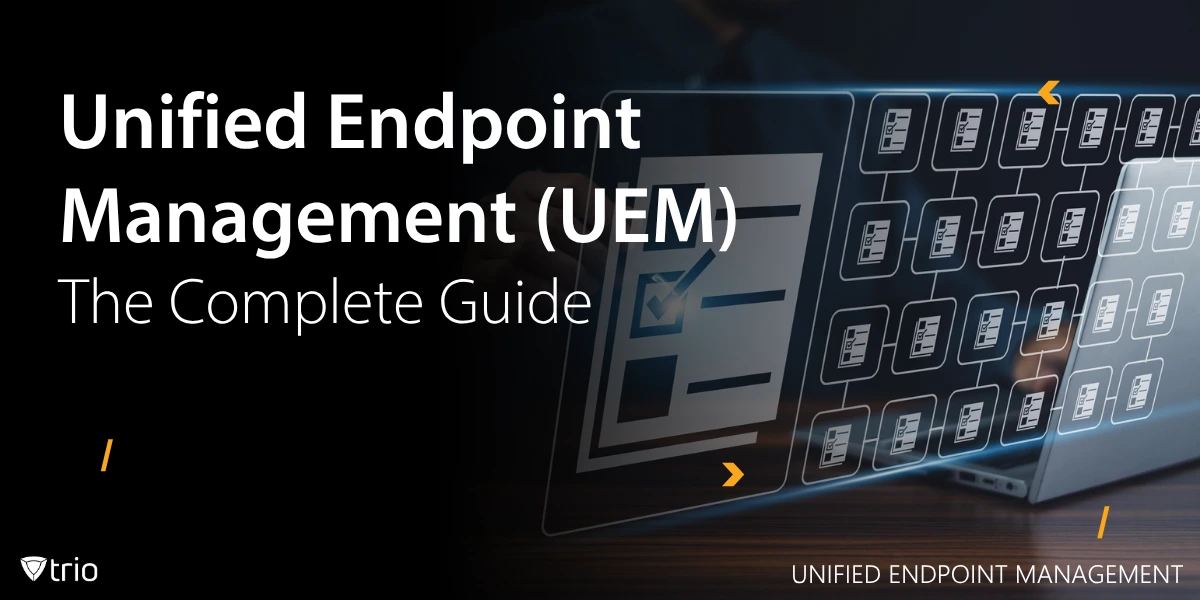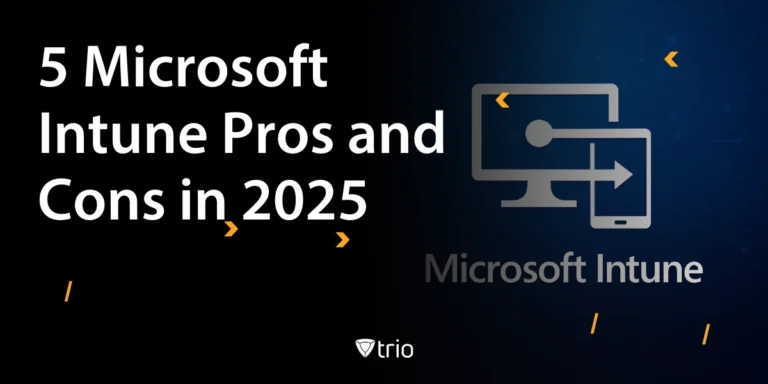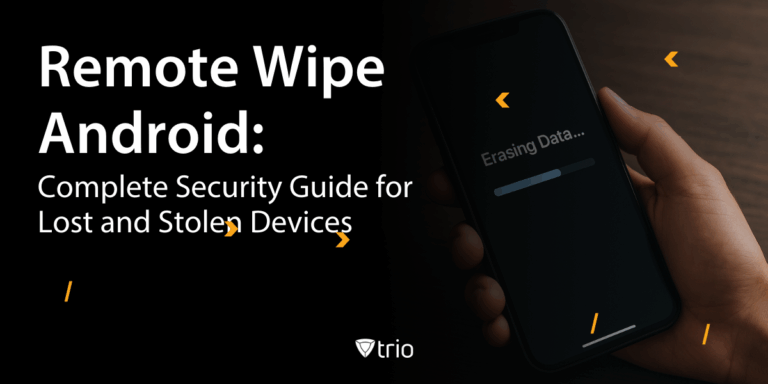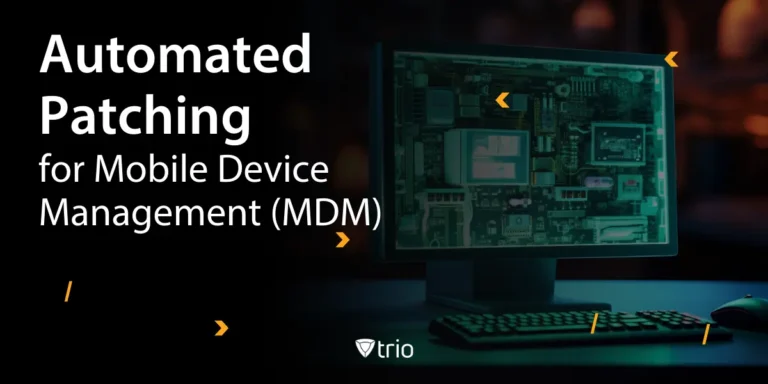Managing mobile devices, laptops, desktops, and even wearables across hybrid workforces is complex, and legacy tools like MDM and EMM can’t keep up. The result? Wasted hours, inconsistent security policies, and mounting compliance risks.
That’s where Unified Endpoint Management (UEM) steps in. More than just a newer version of MDM, UEM brings every endpoint under one pane of glass, helping SMB IT admins streamline device control, boost security, and scale smarter.
What Is UEM?
Unified Endpoint Management (UEM) unifies control of all endpoints, laptops, smartphones, tablets, and IoT devices, under a single platform. It goes beyond traditional MDM by offering centralized visibility, security enforcement, and automation across operating systems like Windows, macOS, iOS, Android, and more.
Modern UEM tools enable IT administrators to remotely configure, monitor, and secure every device connected to the company network, without requiring on-premises infrastructure. This includes everything from patching laptops to enforcing app-level security policies on smartphones.
Why UEM Matters
Modern small to medium-sized businesses (SMBs) face mounting pressure to manage growing fleets of endpoints while maintaining security and performance, often with limited tools and lean staff.
Pain Points
- Tool Fragmentation: Multiple tools for different device types create silos, increase complexity, and make visibility difficult.
- Time-Consuming Manual Work: IT teams spend over 15 hours a week on repetitive tasks like device setup, updates, and enforcing policies.
- Vulnerable Endpoints: According to Automox, up to 60% of data breaches stem from unpatched, but known, vulnerabilities. Inconsistent tools make patching harder.
- Limited Scalability: Legacy tools weren’t built for BYOD policies or hybrid work strategies. Growth multiplies the management burden.
- Inconsistent Compliance: Enforcing standards like ISO or HIPAA becomes unmanageable when device controls vary across systems.
UEM Benefits
- Centralized Device Control: Manage smartphones, desktops, laptops, and IoT from one interface regardless of OS or location.
- Cross-Platform Security Policies: Apply unified encryption, password, and access rules across Windows, macOS, iOS, Android, and more.
- Automated Compliance Enforcement: Push configurations and generate audit-ready reports without chasing down each device manually.
- Real-Time Visibility: Monitor patch status, device health, usage, and connections in real time across the entire fleet.
- Empowered End Users: Enable features like self-enrollment and password resets to reduce IT tickets and improve productivity.
How UEM Works
Unified Endpoint Management simplifies IT workflows by consolidating device setup, policy enforcement, and remote operations into a single platform. Here's how a typical UEM workflow looks in practice:
- Device Onboarding: Devices are enrolled via self-service portals, QR codes, or email links, supporting both corporate and BYOD policies. Zero-touch enrollment is often available for faster setup.
- Policy Enforcement: Security configurations, such as forced encryption, password strength requirements, or app restrictions, are pushed to devices immediately upon enrollment.
- Remote Management: IT admins can patch systems, deploy software, lock/wipe lost devices, and monitor performance all without physical access to the endpoint.
- Device Lifecycle Management: Devices are continuously tracked for compliance, health, usage, and location, supporting proactive issue resolution and asset management.
Key Features to Look For
Choosing the right UEM solution starts with knowing what matters most. Below are essential capabilities IT admins at SMBs should expect and a few extras that add serious value.
Must-Have Features
- Multi-OS Support: Full compatibility with Windows, macOS, iOS, and Android ensures consistent policy enforcement across your device fleet.
- Zero-Trust Security Integration: Enforce granular access controls, encryption, and identity verification using zero-trust architecture principles.
- Centralized Monitoring: A unified dashboard to track device status, patch levels, policy compliance, and user activity in real time.
- Automated Device Enrollment: Support for zero-touch setup and QR/email-based onboarding, streamlining deployment at scale.
- Remote Configuration & Wipe: Push settings, install apps, and wipe lost or decommissioned devices without needing physical access.
Nice-to-Have Features
- IoT Device Support: Ability to manage printers, wearables, and other connected devices beyond phones and laptops.
- AI-Driven Anomaly Detection: Use machine learning to flag unusual activity, potential breaches, or non-compliant behavior before it escalates.
- App Wrapping & Containerization: Separate work and personal data on BYOD devices for better privacy and policy enforcement.
- Integration with Existing Tools: Seamless interoperability with Active Directory, Microsoft 365, Google Workspace, antivirus, and firewalls.
Ready to Simplify Endpoint Management?
With Trio, you don’t just get a UEM platform; you get a smarter way to manage devices, reduce IT overhead, and stay secure at scale. Whether you're running a small team or scaling fast, Trio gives you the flexibility and visibility you need, without the complexity.
🎯 Book a free demo to see how Trio works for your setup.
🚀 Start your free trial and take control of your endpoints today.
Conclusion
Unified Endpoint Management has become essential for modern IT operations, especially for resource-constrained SMBs. By consolidating tools, enforcing consistent security, and simplifying device control, UEM enables teams to do more with less.
The right UEM solution doesn’t just reduce risk; it drives efficiency. And with Trio, getting started is easier than ever.
Frequently Asked Questions
Yes, Intune is a UEM tool, but it’s optimized for Microsoft-centric environments. For SMBs needing broader OS support (macOS, Linux, IoT) and simpler pricing, platforms like Trio UEM offer more flexibility without Azure dependencies.
UEM enforces uniform security policies (encryption, patch management, remote wipe) across all devices—whether laptops, phones, or IoT. For example, Trio automatically blocks non-compliant devices (outdated OS, disabled encryption) from accessing corporate data.
Partially. UEM consolidates device management (MDM) and basic endpoint security (patch enforcement, app control), but most SMBs still need dedicated EDR/antivirus for advanced threat detection. Trio integrates with leading security tools for layered protection.
UEM cuts IT workload by 30-50% by automating device onboarding, policy enforcement, and compliance reporting. With Trio, SMBs reduce breach risks while reclaiming 15+ hours/week spent on manual tasks
Get Ahead of the Curve
Every organization today needs a solution to automate time-consuming tasks and strengthen security.
Without the right tools, manual processes drain resources and leave gaps in protection. Trio MDM is designed to solve this problem, automating key tasks, boosting security, and ensuring compliance with ease.
Don't let inefficiencies hold you back. Learn how Trio MDM can revolutionize your IT operations or request a free trial today!





